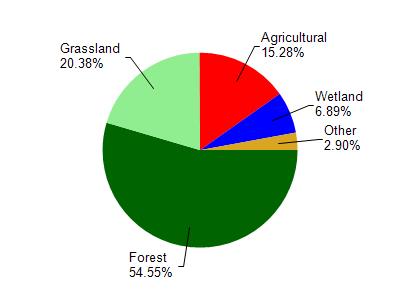Dane, Iowa
Yes
No
No
Fish and Aquatic Life
Overview
This branch starts at the confluence of Ryan and Elvers creeks. It has a relatively low gradient
and portions have been ditched. It is a flashy stream that often floods during spring melts and
major storms. As a result, the stream bottom has problems with siltation. Currently, the
stream is managed as a Class III trout stream but has the potential to be a Class II stream with
the proper management. The stream has public ownership along about one mile of its length.
This land provides a diverse mix of habitat types for wildlife and is used as a public hunting
ground.
From: Ripp, Coreen, Koperski, Cindy and Folstad, Jason. 2002. The State of the Lower Wisconsin River Basin. PUBL WT-559-2002. Wisconsin Department of Natural Resources, Madison, WI.
Date 2002
Author Cynthia Koperski
Historical Description
This branch starts at the confluence of Ryan and Elvers creeks. It has a relatively low
gradient and portions have been ditched. It is a flashy stream, often flooding during
spring melts and major storms (DCRPC, 1992). It is a Class III trout stream (WDNR,1980)
with public ownership along about one mile of its length (WDNR, 1980, DCRPC, 1992).
Date 1994
Author Surface Water Inventory Of Wisconsin
Historical Description
East Branch Blue Mounds Creek (Bohn) - Mouth location T8N R5E Section 25 -15, surface area = 0.8 acres, Length =0.6 miles, Gradient = 0.0 feet per mile, Total alkalinity = 266.0 mg/l, Volume of flow = 16.7 cfs.
As its name states, it is a principal tributary of Blue Mounds Creek. It is spring fed and considered a very good trout stream in Dane County wherein most of its watershed lies. Flooding is a recurring problem since most of its watershed is farmed. The best trout water is in its upper portions where there is some natural reproduction. From the standpoint
of flow it is one of the largest streams in Iowa County and contributes about 48 percent of the base flow of Blue Mounds Creek. Waterfowl are limited but marshland furbearers such as muskrats and raccoons are common near the
mouth where a large proportion of the immediate drainage area is in meadow pasture. The upper portions of the stream support brown and rainbow trout which are stocked on an annual basis and reproduce naturally. Forage fishes common to Blue Mounds Creek are also present. There are no public lands in Iowa County but it can be reached from a town road which crosses it just over the county line.
From: Piening, Ronald and Threinen, C.W., 1968. Lake and Stream Classification Project. Surface Water Resources of Iowa County, Wisconsin Department of Natural Resources, Madison, WI.
Date 1968
Author Surface Water Inventory Of Wisconsin
Condition
Wisconsin has over 84,000 miles of streams, 15,000 lakes and milllions of acres of wetlands. Assessing the condition of this vast amount of water is challenging. The state's water monitoring program uses a media-based, cross-program approach to analyze water condition. An updated monitoring strategy (2015-2020) is now available. Compliance with Clean Water Act fishable, swimmable standards are located in the Executive Summary of Water Condition in 2018. See also the 'monitoring and projects' tab.
Reports
Management Goals
Wisconsin's Water Quality Standards provide qualitative and quantitative goals for waters that are protective of Fishable, Swimmable conditions [Learn more]. Waters that do not meet water quality standards are considered impaired and restoration actions are planned and carried out until the water is once again fishable and swimmable
Management goals can include creation or implementation of a Total Maximum Daily Load analysis, a Nine Key Element Plan, or other restoration work, education and outreach and more. If specific recommendations exist for this water, they will be displayed below online.
Monitoring
Monitoring the condition of a river, stream, or lake includes gathering physical, chemical, biological, and habitat data. Comprehensive studies often gather all these parameters in great detail, while lighter assessment events will involve sampling physical, chemical and biological data such as macroinvertebrates. Aquatic macroinvertebrates and fish communities integrate watershed or catchment condition, providing great insight into overall ecosystem health. Chemical and habitat parameters tell researchers more about human induced problems including contaminated runoff, point source dischargers, or habitat issues that foster or limit the potential of aquatic communities to thrive in a given area. Wisconsin's Water Monitoring Strategy was recenty updated.
Grants and Management Projects
| Project Name (Click for Details) | Year Started |
|---|
|
|
Monitoring Projects
| WBIC | Official Waterbody Name | Station ID | Station Name | Earliest Fieldwork Date | Latest Fieldwork Date | View Station | View Data |
|---|
| 1251100 | East Branch Blue Mounds Creek | 10009326 | East Branch Blue Mounds Creek At Reeve Rd. | 8/12/2019 | 8/12/2019 | Map | Data |
|

Watershed Characteristics
East Branch Blue Mounds Creek is located in the Mill and Blue Mounds Creek watershed which is 186.74 mi². Land use in the watershed is primarily forest (54.60%), grassland (20.40%) and a mix of agricultural (15.30%) and other uses (9.80%). This watershed has 382.87 stream miles, 106.91 lake acres and 6,596.99 wetland acres.
Nonpoint Source Characteristics
This watershed is ranked Medium for runoff impacts on streams, Low for runoff impacts on lakes and High for runoff impacts on groundwater and therefore has an overall rank of High. This value can be used in ranking the watershed or individual waterbodies for grant funding under state and county programs.However, all waters are affected by diffuse pollutant sources regardless of initial water quality. Applications for specific runoff projects under state or county grant programs may be pursued. For more information, go to surface water program grants.